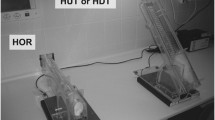Summary
-
1.
Two types of short latency blood pressure responses to hypothalamic stimulation have been studied. An “initial” pressor or depressor response could be elicited in the rat as well as in the cat. “Secondary” responses, normally depressor, were observed in the rat.
-
2.
In the rat, response reversal may be brought about by changes both in amplitude and frequency of stimulation.
-
3.
Response reversals with identical hypothalamic stimuli can be seen after changes in basal blood pressure induced by carotid compression as well as various vasoactive agents. The initial response types reverse at extreme blood pressure levels, whereas secondary waves reverse at medium blood pressure levels.
-
4.
The presence of secondary waves depends upon anesthesia as well as upon the basal blood pressure.
-
5.
Hypothalamic stimulation may induce temporary instability of basal blood pressure (vasomotor waves), especially during induced hypertension. Such stimulation may also induce irreversible shifts in basal blood pressure in either the hyper-or the hypotensive direction.
-
6.
Factors leading to the appearance of pronounced secondary waves, i. e. rendering the response oscillatory seem to be the same as those favouring vasomotor waves viz. anesthesia and hypertension.
Zusammenfassung
-
1.
Zwei Typen von Blutdruckreaktionen kurzer Latenz auf hypothalamische Stimulationen wurden untersucht. Eine “initiale” pressorische oder depressorische Reaktion konnte sowohl bei der Ratte als auch bei der Katze nachgewiesen werden. “Sekundäre”, normalerweise depressorische Reaktionen wurden bei der Ratte beobachtet.
-
2.
Bei der Ratte kann eine Umkehr der Reaktionsrichtung sowohl durch Änderung der Reizamplitude als auch der Reizfrequenz hervorgerufen werden.
-
3.
Umkehr der Reaktionsrichtung mit identischen hypothalamischen Reizen kann nach änderung des normalen Blutdruckes sowohl durch Carotiskompression als auch durch verschiedene vasoaktive Stoffe beobachtet werden. Die initialen Reaktionstypen kehren sich bei extremen Blutdruckwerten um, während die sekundären Wellen dies bei mittleren Blutdruckwerten tun.
-
4.
Die Anwesenheit von sekundären Wellen hängt sowohl von der Anästhesie als auch vom Ausgangsblutdruck ab.
-
5.
Stimulation des Hypothalamus kann vorübergehende Unstabilität des normalen Blutdruckwertes (vasomotorische Wellen) besonders während induzierter Hypertension hervorrufen. Diese Stimulationen können auch irreversible änderungen des normalen Blutdruckes sowohl im Sinne einer Hyper- als auch einer Hypotension bewirken.
-
6.
Faktoren, welche zum Auftreten von ausgesprochenen sekundären Wellen führen, d. h. welche den Reaktionen einen oszillatorischen Charakter verleihen, scheinen dieselben zu sein, wie die, welche die vasomotorischen Wellen fördern, nämlich Anästhesie und Hypertension.
Résumé
-
1.
Deux types de réactions de la pression artérielle d'état de latence courte après stimulation hypothalamique furent démontrés. Une réaction «initiale» de pression ou de dépression pouvait être déclanchée chez le rat et le chat. Des réactions «secondaires» normalement de charactère dépressif furent observées chez le rat.
-
2.
Chez le rat un renversement de réaction peut être provoqué par altérations de l'amplitude et de la fréquence de la stimulation.
-
3.
Renversements des réactions avec des stimuli hypothalamiques identiques peuvent être provoquées après modification de la pression artérielle normale soit par compression de la carotide soit par des agents divers vasoactifs. Les types des réactions initiales montrent une inversion sous des valeurs extrêmes de la pression artérielle tandis que les ondes secondaires montrent cet effet sous une pression artérielle de valeur moyenne.
-
4.
La présence des ondes secondaires dépend soit de l'anaesthesie soit de la pression artérielle normale.
-
5.
Stimulation de l'hypothalamus peut provoquer temporairement une labilité de la pression artérielle normale (ondes vasomotrices) surtout pendent une hypertension artificielle. Ces stimulations peuvent aussi provoquer des altérations irreversibles de la pression artérielle normale soit dans le sens d'une hyper- soit d'une hypotension.
-
6.
Les facteurs qui mènent à l'apparition d'ondes secondaires c. a. d. qui donne à la réaction un caractère oscillatoire, paraient être les mêmes que ceux qui favorisent des ondes vasomotrices c. a. d. l'anaesthesie et l'hypertension.
Similar content being viewed by others
References
Scherrer, H. F., andS. M. Friedman, A sustained pressor response to hypothalamic stimulation in the rat. Acta endocr.27 (1958), 89–98.
Ranson, S. W., andH. W. Magoun, The hypothalamus. Erg. Physiol.41 (1939), 56–163.
Hare, K., andW. A. Geohegan, Influence of frequency of stimulation upon response to hypothalamic stimulation. J. Neurophysiol., Springfield,4 (1941), 266–273.
Kurotsu, T., G. Shinya andT. Ban, Studies on the influence of the electrical stimulation with different frequencies upon the hypothalamus. Med. J. Osaka Univ.5 (1954), 653–700.
Wagner, R., Probleme und Beispiele biologischer Regelung. Georg Thieme, Stuttgart, 1954.
Selbach, H., Das Kippschwingungsprinzip in der Analyse der vegetativen Selbststeuerung. Fortschr. Neurol.17 (1949), 129–150 and 151–169.
Steinmann, B., R. Illig andH. Henzi, Die Beeinflussung des Carotissinusreflexes durch psychische Belastung. Schweiz. med. Wschr.85 (1955), 35–37.
Heinbecker, P., The pathogenesis of diastolic hypertension. Surgery, S. Louis,23 (1948), 618–638.
Kubicek, W. G., F. J. Kottke, D. J. Laker andM. B. Visscher, Adaptation in the pressorreceptor reflex mechanisms in experimental neurogenic hypertension. Amer. J. Physiol.175 (1953), 380–382.
Lindgren, P., The mesencephalon and the vasomotor system. Acta physiol. Scand.35, Suppl. 121 (1955).
Lacey, J. I., The evaluation of autonomic responses: Toward a general solution. Ann. N. Y. Acad. Sc.67 (1956), 123–164.
Wilder, J., Das “Ausgangswert-Gesetz”, ein unbeachtetes biologisches Gesetz und seine Bedeutung für Forschung und Praxis. Zschr. Neurol., Berlin,137 (1931), 317–338.
Scherrer, H., unpublished observation.
Darrow, C. W., andE. Gellhorn, The effects of Adrenaline on the reflex excitability of the autonomic nervous system. Amer. J. Physiol.127 (1939), 243–251.
Celander, O., andB. Folkow, Are parasympathetic vasodilator fibers involved in depressor reflexes elicited from the baroceptor regions? Acta physiol. Scand.23 (1951), 64–77.
Cannon, P., W. Raule andH. Schaefer, Zur Physiologie eines sympathischen Ganglions und zur Frage der Vasodilatatoren und des sympathischen Tonus. Pflügers Arch. Physiol.260 (1954), 116 bis 136.
Folkow, B., andU. S. v. Euler, Selective activation of Noradrenaline and Adrenaline producing cells in the cat's adrenal gland by hypothalamic stimulation. Circ. Research2 (1953), 191–195.
Gellhorn, E., Autonomic Imbalance and the Hypothalamus. Univ. of Minnesota Press, Minneapolis, 1957.
Author information
Authors and Affiliations
Additional information
With 12 Figures
Rights and permissions
About this article
Cite this article
Scherrer, H. Hypothalamic stimulation and blood pressure homeostasis. Acta Neurovegetativa 20, 205–218 (1959). https://doi.org/10.1007/BF01235053
Issue Date:
DOI: https://doi.org/10.1007/BF01235053




